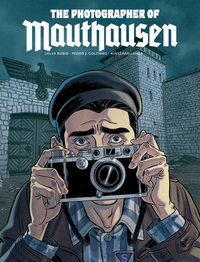Take a photo of a barcode or cover
I requested this graphic novel on Netgalley and I'm so glad I did!
It's just heartbreaking how the protagonist of this graphic novel risks everything just so he can get the proof of what's going on out into the world. It's a grueling read since it depicts inhumane treatment of all kinds without sensationalizing or sugarcoating anything. But then things get even sadder as the proof he so painstakingly obtained fails to generate the effect that it should have!
In any case, I'd have rated the novel higher had I not experienced Elie Weisel's Night.
It's just heartbreaking how the protagonist of this graphic novel risks everything just so he can get the proof of what's going on out into the world. It's a grueling read since it depicts inhumane treatment of all kinds without sensationalizing or sugarcoating anything. But then things get even sadder as the proof he so painstakingly obtained fails to generate the effect that it should have!
In any case, I'd have rated the novel higher had I not experienced Elie Weisel's Night.
dark
emotional
informative
reflective
sad
slow-paced
This was an emotional story, but unfortunately I wasn't invested in any of the characters. They were really hard to tell apart from each other and this was way too short to properly give the story its space. There's a scene at the end where the protagonist isn't given the opportunity to talk about what happened, which felt like a weird analogy for the author and this book.
I received an ARC of this audiobook through NetGalley in exchange for my unbiased opinion.
Francisco Boix was a Spanish press photographer who fled to France at the beginning of World War II. There, he and other communists were handed over by the French to the Nazis and sent to Mauthausen concentration camp. When the Nazis learn about his photography skills, he is put to work processing photos taken in the camp. When he is made to develop pictures of the deaths of prisoners in the camp, Francisco realizes this is his chance to share with the outside world the atrocities being committed in the camp. Knowing he is risking not only his own life but the lives of others at the camp, Francisco vows to do whatever it takes to get these photos out to the world.
This is a true story of one of the many atrocities experienced in the concentration camps at the hands of Nazis in World War II. The illustrations capture the horrors of Mauthausen, making this a powerful, moving graphic novel. This book makes me want to learn more about Boix. I highly recommend this graphic novel!
Francisco Boix was a Spanish press photographer who fled to France at the beginning of World War II. There, he and other communists were handed over by the French to the Nazis and sent to Mauthausen concentration camp. When the Nazis learn about his photography skills, he is put to work processing photos taken in the camp. When he is made to develop pictures of the deaths of prisoners in the camp, Francisco realizes this is his chance to share with the outside world the atrocities being committed in the camp. Knowing he is risking not only his own life but the lives of others at the camp, Francisco vows to do whatever it takes to get these photos out to the world.
This is a true story of one of the many atrocities experienced in the concentration camps at the hands of Nazis in World War II. The illustrations capture the horrors of Mauthausen, making this a powerful, moving graphic novel. This book makes me want to learn more about Boix. I highly recommend this graphic novel!
eARC provided by Netgalley
The Photographer of Mauthausen is a graphic novel adaptation of the life of Francisco Boix – a man I didn’t know anything about prior to picking up this work, but about whom I wish to know more now that I finished it.
The comic obviously comes with a plethora of content warnings: violence and torture, concentration camps, nudity and war being the ones I can think of.
The story is well-told – the artwork fits the dark and somber atmosphere and the narrative manages to maintain a feeling of hope despite the rather grim reality it portrays. It is obvious a lot of research went in the making of this comic and it shows in the details incorporated in it. My sole issue with the story is that it is told in a rather concise fashion – over the span of 100 or so pages - which was probably the reason I had trouble getting in the storyline.
This comic did spark my curiosity, so I'll be looking for more resources on Boix in the future.
The Photographer of Mauthausen is a graphic novel adaptation of the life of Francisco Boix – a man I didn’t know anything about prior to picking up this work, but about whom I wish to know more now that I finished it.
The comic obviously comes with a plethora of content warnings: violence and torture, concentration camps, nudity and war being the ones I can think of.
The story is well-told – the artwork fits the dark and somber atmosphere and the narrative manages to maintain a feeling of hope despite the rather grim reality it portrays. It is obvious a lot of research went in the making of this comic and it shows in the details incorporated in it. My sole issue with the story is that it is told in a rather concise fashion – over the span of 100 or so pages - which was probably the reason I had trouble getting in the storyline.
This comic did spark my curiosity, so I'll be looking for more resources on Boix in the future.
Disclaimer: Arc via Netgalley
Francisco Boix was a Spanish Communist who fled to France and then with the invasion of Germany was sent to Mauthausen as a political prisoner. His photographs that he hid in Mauthausen, at great risk to himself, played a role in the war crime trials that followed the end of WW II. He is often overlooked in American history classes because he was a Communist (and died long before the Wall fell) and Spanish. But he is important because of the evidence that he preserved.
Rudio’s graphic novel is partial biography, detailing what might have happened or did happened in the camp as Boix finds himself in a position to gain evidence of the war crimes committed in the camp. The horrors of the camp are not softened in the graphic novel. The layout and conveying of the story not only illustrate the dangers in saving the historical record, but also in the various ways the evidence was used in the war crime trials as well as the purpose of the trials themselves.
Highly recommended.
Francisco Boix was a Spanish Communist who fled to France and then with the invasion of Germany was sent to Mauthausen as a political prisoner. His photographs that he hid in Mauthausen, at great risk to himself, played a role in the war crime trials that followed the end of WW II. He is often overlooked in American history classes because he was a Communist (and died long before the Wall fell) and Spanish. But he is important because of the evidence that he preserved.
Rudio’s graphic novel is partial biography, detailing what might have happened or did happened in the camp as Boix finds himself in a position to gain evidence of the war crimes committed in the camp. The horrors of the camp are not softened in the graphic novel. The layout and conveying of the story not only illustrate the dangers in saving the historical record, but also in the various ways the evidence was used in the war crime trials as well as the purpose of the trials themselves.
Highly recommended.
challenging
dark
emotional
informative
inspiring
reflective
tense
medium-paced
dark
emotional
informative
reflective
tense
fast-paced
Un cómic basado en sucesos reales que se queda corto en el guión y cuya fidelidad al registro histórico le resta en lo gráfico. Me queda la convicción de que en manos de Paco Roca hubiese sido una obra maestra y aquí se queda en un trabajo respetable sin mas.
dark
informative
sad
fast-paced
Sehr schöne Bilder und interessante Geschichten mit extra Informationen sehr lesenswert



